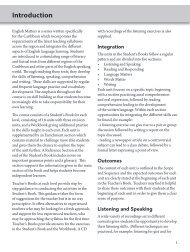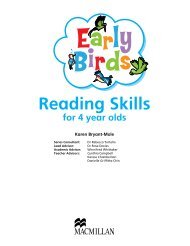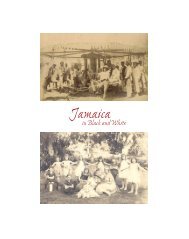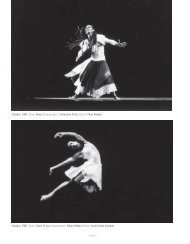Curry, Callaloo & Calypso - Macmillan Caribbean
Curry, Callaloo & Calypso - Macmillan Caribbean
Curry, Callaloo & Calypso - Macmillan Caribbean
You also want an ePaper? Increase the reach of your titles
YUMPU automatically turns print PDFs into web optimized ePapers that Google loves.
<strong>Curry</strong>, <strong>Callaloo</strong><br />
& <strong>Calypso</strong><br />
9780230038578.indd 1 25/07/2011 13:08
9780230038578.indd 2 25/07/2011 13:08
<strong>Curry</strong>, <strong>Callaloo</strong><br />
& <strong>Calypso</strong><br />
The real taste of Trinidad & Tobago<br />
Wendy Rahamut<br />
9780230038578.indd 3 25/07/2011 13:08
For ADARA<br />
<strong>Macmillan</strong> Education<br />
Between Towns Road, Oxford, OX4 3PP<br />
A division of <strong>Macmillan</strong> Publishers Limited<br />
Companies and representatives throughout the world<br />
www.macmillan-caribbean.com<br />
ISBN: 978-0-230-03857-8<br />
Text © Wendy Rahamut 2011<br />
Design and illustration © <strong>Macmillan</strong> Publishers Limited 2011<br />
Photographs © Michael Bonaparte 2011 except pp 12–13 © Alex Smailes 2011<br />
All rights reserved; no part of this publication may be<br />
reproduced, stored in a retrieval system, transmitted in any<br />
form or by any means, electronic, mechanical, photocopying,<br />
recording, or otherwise, without the prior written permission<br />
of the publishers.<br />
Design by John Barker<br />
Typeset by CjB Editorial Plus<br />
Photographs by Michael Bonaparte except pp 12–13 by Alex Smailes<br />
Cover design by John Barker<br />
Cover photographs by Michael Bonaparte<br />
Printed and bound in Malaysia<br />
2015 2014 2013 2012 2011<br />
10 9 8 7 6 5 4 3 2 1<br />
9780230038578.indd 4 25/07/2011 13:08
Contents<br />
Introduction 7<br />
A brief culinary history 12<br />
Snacks and Indian delicacies 21<br />
Soups, salads and vegetables 67<br />
Fish and seafood 115<br />
Mainly meat 159<br />
Rice, coo coo and provisions 197<br />
Cakes, pastries, desserts and ice creams 229<br />
Breads, bakes and pancakes 275<br />
Confections, jams and jellies 317<br />
Drinks 337<br />
Chutneys and pepper sauces 349<br />
Conversion tables 359<br />
Index 361<br />
9780230038578.indd 5 25/07/2011 13:08
9780230038578.indd 6 25/07/2011 13:08
Introduction<br />
We are a nation in love with our foods and never is the time not right to enjoy a good pot<br />
of pelau, hot doubles, a spicy roti and curry, or a hot shark and bake. The idea for a ‘T & T’<br />
cookbook came to me a few years ago when I realized that globalization and foreign influences<br />
might dilute our local cuisine – or that was my opinion at the time. I envisaged a book that<br />
would showcase all our indigenous foods, by way of old and new recipes, for present and future<br />
generations! When I actually started to collect the recipes I realized that much is still cooking in<br />
our home kitchens, and as a result of globalization we have in fact embraced many more recipes<br />
into our lives. There is even a renewed interest in cooking local sparked by the Internet and<br />
cooking programmes on both cable and local TV.<br />
Growing up in the sixties in the town of San Fernando (it’s now a city), local food was not<br />
celebrated as it is today. Indian and Creole foods were mainly cooked in people’s homes, by<br />
either hired cooks or the head of the household. The only Indian food for sale was found in a<br />
wrap roti from roti shops and doubles at the street corner doubles vendor. Creole foods were<br />
hardly ever served up outside. School lunches brought from home were rarely shared between<br />
friends! Snacks then included pepper mango and chilli bibbi, and the occasional aloo pie from<br />
the school snackette. Eating out was only for special occasions and the choices were slim: Chinese<br />
food at Marsang’s restaurant in San Fernando, where they wokked up some of the tastiest<br />
Cantonese dishes I have ever tasted, and, when we were in Port of Spain, Ling Nam restaurant<br />
on Charlotte Street. Steak dinners were enjoyed at Chaconia Inn or Bel Air Restaurant, Piarco,<br />
and these were just for the grown-ups. Usually, for any celebration, the entertaining was done at<br />
home.<br />
Fast forward to the twenty-first century: industrialization, education, travel, migration to<br />
urban areas, inter-racial marriages and technological advancement have all worked in favour of<br />
knocking down racial divides and bringing together our ethnicities. This unity of our races is no<br />
more apparent than in our cuisine. Today, the foods reflecting the rich culinary heritage of our<br />
forefathers are enjoyed by everyone, so much so that our cuisine has transcended itself, marking<br />
out a permanent place on our cultural landscape and on the world culinary map. Our 50:40:10<br />
per cent ethnic make-up of African:Indian:European and Chinese respectively is shown in a<br />
cuisine that is bold, explosive in flavour, eclectic and addictive.<br />
Opposite: Nariva Swamp meets the sea. Above: Port of Spain<br />
9780230038578.indd 7 25/07/2011 13:08<br />
7
Our annual Carnival unites our people further; calypsonians<br />
even pay homage to both cuisine and country with calypsos<br />
such as Denyse Plummer’s ‘Nah Leaving’ and David Rudder’s<br />
‘Trini to d Bone’. What began as the land of calypso, steel band<br />
and limbo, has evolved into the land of calypso, soca (a more<br />
upbeat calypso music), chutney (a fiery Indian baggan or song),<br />
most recently chutney soca (a fusion of Indian and African<br />
music), limbo and of course, still, the ever-engaging alwaysmesmerizing<br />
steel-band music. Carnival is a festival which pulls<br />
many foreign visitors to our shores and gives us a chance to<br />
display our warm hospitality. In so doing we are able to ‘show<br />
off’ the many foods we as Trinidadians and Tobagonians hold<br />
dear to our hearts – bake and shark, crab and dumpling, corn<br />
soup, pelau, roti, rum punch, stew, accras, callaloo and coo coo,<br />
mauby, sugar cakes and bene balls, to name but a few!<br />
<strong>Curry</strong>, <strong>Callaloo</strong> & <strong>Calypso</strong> celebrates this unity<br />
by embracing all our cuisines; no more are<br />
ethnic-specific foods prepared only at home by<br />
the relevant ethnic group. Good cooks abound<br />
on our islands, some with modern techniques<br />
and some who still hold on to traditional<br />
methods. Ours is cooking from the soul, always<br />
good, always tasty, gutsy and comforting.<br />
Breakfast is offered in sada rotis,<br />
sandwiched with a variety of cooked<br />
vegetables, and bakes, also with a variety<br />
of fillings, fish salads and accras (fritters).<br />
Lunch, which used to be the main meal of the<br />
day, is now mostly enjoyed while on the job,<br />
purchased at many small eateries across our<br />
islands and comprising a hot local lunch of a<br />
hearty soup or stewed meat or fish,<br />
provision, peas, rice and a salad.<br />
Dinner is home-cooked: a stew,<br />
grilled or curried meat or fish, with<br />
a provision or rice, and a vegetable.<br />
Dessert is usually cake and ice cream,<br />
but not just any ice cream – local<br />
flavours here range from coconut<br />
to sour sop, passion fruit, guava,<br />
and even Guinness. Fresh fruits are<br />
enjoyed round the clock. Nothing<br />
beats peeling down a starch mango<br />
with your teeth and biting into the<br />
sweet flesh, while juice runs down to<br />
your elbows! Or savouring a sugary<br />
ripe sapodilla, rich with aromatics,<br />
tender and juicy, or being amazed at<br />
the beauty of a Pink Lady paw paw<br />
just sliced open.<br />
8<br />
Steel bands<br />
Carnival characters<br />
9780230038578.indd 8 25/07/2011 13:08
Lunch menu board<br />
Mangrove roots<br />
Goats<br />
We are an agriculturally rich<br />
nation. The foundation of our<br />
cuisine is found in the heart of the<br />
Paramin Hills, from where we reap<br />
the bounty of fresh herbs. These<br />
herbs are ground together to form a<br />
herb paste which we use to marinate<br />
our seafood and meats prior to<br />
cooking. Our provisions, vegetables<br />
and fruits are grown locally and<br />
offered at our outdoor markets and<br />
vegetable stands.<br />
Coconut is a big ingredient with<br />
a seductive flavour. We use the<br />
milk in soups and rice dishes, we<br />
make candies from grated coconut,<br />
and it’s an important ingredient<br />
in coconut bake, sweet bread and<br />
drops. Stewed with sugar and spices<br />
it is used to fill turnovers and fancy<br />
sweet bread rolls.<br />
The now defunct sugar-cane<br />
industry once gave us our sweet<br />
cane sugar, which in turn was<br />
processed into world-class local<br />
rums. Our first-grade granulated and<br />
brown sugars, thickest and blackest<br />
molasses, were used to prepare local<br />
candies and jams. We still enjoy cane<br />
sugar but sadly it’s now imported<br />
from Guyana and other <strong>Caribbean</strong><br />
countries. Today it has melted to<br />
a small cottage industry with a<br />
sprinkling of farmers selling fresh<br />
cut cane and sweet cane juice.<br />
From our oceans we get our fish<br />
and seafood fresh on a daily basis.<br />
We fish our rivers for cascadura and<br />
other river fish and we catch mud<br />
crabs in our mangrove swamps.<br />
Meat plays an important part in our<br />
cuisine; beef, goat, lamb, chicken<br />
and pork are consumed regularly<br />
and are either home-grown or<br />
imported. Our forests provide the<br />
perfect environment for seasonal<br />
wild-meat hunting, during which<br />
time (October to December) agouti,<br />
lappe, iguana and manicou are<br />
hunted and cooked.<br />
9780230038578.indd 9 25/07/2011 13:08<br />
9
Guava<br />
10<br />
Bundles of chive<br />
at market<br />
When we start a Trini pot cooking, we first fry a mixture of garlic,<br />
onions, herbs and peppers in some oil before adding our meats. This<br />
resembles the sofrito of the Spanish <strong>Caribbean</strong> islands, and it’s a<br />
method that was left by our Spanish forefathers. Other times we<br />
caramelize sugar to a rich brown colour then add the meat. This<br />
effective browning method comes from our African ancestors and<br />
results in a perfectly coloured stew. Bright red roucou (annatto) was<br />
also used to give a rich-coloured stew. The chonkeying of our dhals<br />
and chokas (burning of garlic and pepper and/or cumin in hot oil)<br />
is a culinary gift from our Indian brothers and sisters – split pea soup<br />
magically turns into dhal when it is chonkeyed; even the sautéing of our<br />
curries in hot oil with garlic is indigenous and essential to a true Trini curry.<br />
All these techniques are important to a Trinidadian cook and it’s what makes<br />
our cuisine so special.<br />
Between the covers of <strong>Curry</strong>, <strong>Callaloo</strong> & <strong>Calypso</strong> you will find traditional<br />
recipes like saltfish buljol, breadfruit oiled down, rotis, curries, stews and<br />
dumplings, bakes and accras, callaloo and coo coo. Foods that I grew up<br />
enjoying as a girl, and foods I still prepare and look forward to eating today<br />
with my family. You will also find some personal favourites that make me<br />
nostalgic for my old Trinidad, like my mother’s coconut cake, old-fashioned<br />
guava cheese, aloo poori roti, juicy sugar cakes.<br />
I am a true lover of the foods of my islands. I hope the spirit of my recipes<br />
will bring you back to your kitchen and that you too will fall in love with a<br />
cuisine that is stunningly diverse and exceptionally delicious.<br />
Coconut vendor, Queen’s Park Savannah<br />
9780230038578.indd 10 25/07/2011 13:08
9780230038578.indd 11 25/07/2011 13:08
A brief culinary history<br />
When Christopher Columbus sailed to the shores of Trinidad and Tobago in 1498, the only visible<br />
inhabitants were the Carib and Arawak tribes. Their diet included root vegetables, such as<br />
cassava from which they made bread and cakes. They also used cassava as a main ingredient in a<br />
dish called ‘matete’, made with crab, lobster or cascadura, and ate it frequently with wild meat<br />
like manicou.<br />
12<br />
9780230038578.indd 12 25/07/2011 13:08
Yams and plantains were other popular staples, as was corn which was roasted or boiled.<br />
Today roast and boiled corn vendors are still found in the country with their open-fire coal-pot<br />
cooking. River fish, like cascadura, and oysters were eaten as well as shrimp, crab and chip chip.<br />
They also ate the fruits of palms such as peewah and the leaves of trees, more specifically the<br />
acoma, and susumba berries. Most were eaten raw or roasted.<br />
Cutting cane<br />
13<br />
9780230038578.indd 13 25/07/2011 13:08
14<br />
Cocoa on the tree<br />
Peewah<br />
Archbishop’s House<br />
Coconut and coconut milk were both eaten raw<br />
and used as an ingredient in their cooking. They made<br />
dumpling soup with roasted cocoa bean, coconut milk<br />
and cassava, and fish was especially enjoyed in soups,<br />
hence the birth or our own ‘fish teas’.<br />
When the Spanish came, with the arrival of Columbus,<br />
they brought with them a more sophisticated cuisine.<br />
They too used corn in abundance but they made<br />
pastelles and arepas, two very familiar dishes that we<br />
still enjoy today. The Spaniards also enjoyed wild meat<br />
and salted fish, or bacalao.<br />
The years 1777 to 1787 saw the arrival of the French<br />
planters, who brought with them their slaves, amongst<br />
whom were a number of excellent cooks. The food was<br />
becoming more plentiful and exciting. The art of making<br />
coconut butter was a household one, and children were<br />
fed fresh cows’ milk and tannia as a large part of their<br />
diet. The French enjoyed a diet rich in wild meat, roast<br />
suckling pig, vegetables and provisions.<br />
Salted fish and salted meats were imported mainly for<br />
their slaves, who were fed on a mixture of vegetables<br />
and provisions, cooked with coconut and occasionally<br />
flavoured with salt meat. They called this sancocho,<br />
and nowadays we still enjoy this dish as a thick soup<br />
flavoured much the same way. The addition of salted<br />
meats is evident today in many local recipes such as<br />
callaloo, split pea based soups and stew peas.<br />
The planters brought French bread with them, which<br />
we enjoy as hops, a dry and crusty roll. In those days<br />
there were a lot of pig farms around the East Dry River<br />
area, enabling the French settlers to make pudding and<br />
souse from the pigs’ blood and trotters respectively after<br />
they were killed. These are still popular delicacies and a<br />
major part of our culinary heritage. ‘Pudding and hops’<br />
is a popular evening meal for many today.<br />
As settler immigration increased, each group brought<br />
their own slaves and in return each set of slaves brought<br />
with them varied ways in the kitchen. At this time the<br />
stage was set for African customs. We must remember<br />
that the slaves did not eat the same foods as their<br />
masters. They would make their own dishes from what<br />
was left over by the great house. While the masters<br />
feasted on wild meat their slaves used the dasheen bush<br />
to make callaloo and ate this with cassava foo-foo. They<br />
also made paime instead of pastelles with the corn and<br />
banana leaves.<br />
9780230038578.indd 14 25/07/2011 13:08
The African slaves also had a great fancy for sweets, and those that worked on the sugar<br />
plantations sometimes received part of their wages in sugar and molasses. They used these<br />
products and turned them into delicious sweetmeats that we still enjoy today. Some have<br />
become quite rare, like ‘nigger boy’ – a caramel-type sweet, ‘halay’ – a sweet with a pulling<br />
quality much like bubble gum, made with sugar and water, and ‘lavanee’ – a hard square<br />
toffee-like sweet in various colours. Toolum, made with molasses, coconut and spices, is still very<br />
popular, as is chip chip – sugar cakes made with coconut pieces and sugar.<br />
La Chapelle Old House<br />
15<br />
9780230038578.indd 15 25/07/2011 13:08
It would be remiss of me not to speak briefly about the cooking methods that were used in<br />
the early days. The slaves would cook for the plantation owners, much of the cooking taking<br />
place in a building away from the great house. In these buildings the slaves usually cooked on an<br />
open fire contained by large stones. The fire was made in the centre and the pots placed upon<br />
the frame of the stones. If baking was done on this fire the pot was placed over the fire, and the<br />
bread dough placed in the pot. The pot was then covered with a sheet of metal and some heat<br />
was placed on top of this metal sheet so as to give heat at both ends. This method was used to<br />
make what we know as ‘pot bake’. Meats were spit-roasted on an open spit. Other baked items<br />
were cooked in a dirt oven, and many areas had a communal oven where anyone could go to<br />
bake their breads and cakes.<br />
By 1797 the English had conquered the islands, also bringing their own slaves, and a<br />
distinctively different type of cooking began to surface. English expertise was shown in the<br />
making of jams and jellies, and beverages like mauby, sorrel and ginger beer.<br />
In 1834 the slaves were emancipated, and from then they refused to work on the plantations.<br />
The skilled cooks amongst them set up shop on street corners, selling dishes they had learned<br />
to cook, such as souse and black pudding, and hence the parlour or shop-front refreshment<br />
stand was born. The land-owners then began to import workers from Barbados, who brought<br />
their own form of recipes such as float and accras and heavy coconut sweet bread. These were<br />
sold under rum shops and in some instances on the street corner. Workers also began to arrive<br />
from China, Portugal and Madeira, all leaving their mark on our culinary map. The largest group<br />
amongst these was the Chinese, whose cooking was changed considerably to suit the palates<br />
of the locals. Their cuisine is very popular as is evident by the number of Trinidad-Chinese<br />
restaurants that exist today.<br />
East Indian immigrants began to arrive between 1845 and 1917, and were registered under<br />
the indenture-ship system to Trinidad. They<br />
brought with them spices like coriander, also<br />
called dhannia, cumin seed (geera), turmeric<br />
or saffron powder, fenugreek, dried legumes<br />
such as channa (chickpeas), rice, and two<br />
sorts of animal: the water buffalo for hard<br />
labour and a type of humped cattle that<br />
provided milk for their beloved yogurt and<br />
butter which was made into ghee. The spices<br />
were ground by hand on what was called<br />
a sill and made into curries, which have<br />
evolved through the years to the distinctively<br />
delicious curry that has become indigenous<br />
to our country.<br />
The East Indians brought not only<br />
ingredients but their own specific methods of<br />
cooking. When they first arrived they began<br />
to cook on a chulla, or mud stove, made with<br />
a combination of river mud, leaves and sticks,<br />
and cow dung. Water was used to smooth<br />
the mud to get a finished look, a process<br />
called leepay. The fire burned from the base<br />
of the chulla. After the chulla came the coal<br />
pot, and then the oil stove followed by the<br />
gasoline stove and, of course, the electric<br />
stove.<br />
16<br />
Indentured labourer certificate<br />
9780230038578.indd 16 25/07/2011 13:08
The Indians made their rotis on a tavah (tawah), or baking stone, over the chulla. They roasted<br />
vegetables to make chokas, ground peas for fritters, and preserved fruits such as mango for<br />
kutchela and amchar to ensure there was a constant supply of hot and sour condiments to<br />
accent their meals. They deep-fried small rotis known as ‘pooris’; today we enjoy the same but<br />
we call them fried bakes. The rotis they cooked when they came were chapattis and parathas;<br />
the chapattis are now known as sada roti, the paratha has remained much the same. Through<br />
the years, they introduced the dhalpouri roti or split pea stuffed roti.<br />
The immigrant Indians improvised in the kitchen to produce foods that were close to those<br />
of their motherland. This improvisation resulted in our local East Indian foods: Indian delicacies,<br />
flaky rotis, curries, condiments, vegetables and sweets, specific only to the <strong>Caribbean</strong>.<br />
At the end of their indenture-ship period the Indians were given the choice of returning to<br />
India or remaining in Trinidad, where they were given the option to purchase land. Those that<br />
chose to stay purchased lands and either remained in the sugar industry or went into farming<br />
cocoa and coconuts on their own estates. Those that embraced cooking started to sell roti in the<br />
parlours. Those roti parlours have become a part of our ‘fast food’ empire here in Trinidad and<br />
are known as roti shops. Others chose to sell ‘doubles’ from bicycles with carts attached. These<br />
have become a national culinary institution, and today doubles vendors can be found all over<br />
the country at varying times of day.<br />
After the Indians came many other settlers, such as the Syrians and more Europeans. They too<br />
have tried to preserve the foods of their homelands and these influences are noted in our cuisine<br />
as well.<br />
Today many of our culinary customs are still observed and some of the methods that have<br />
been described here are still preserved in our rural areas. The foods that we now enjoy are a<br />
direct result of a fusion of those influences left to us by our forefathers. When we talk about the<br />
cuisine of Trinidad and Tobago, it is Indian and Creole foods which top the list of rich inherited<br />
dishes; both form the foundation of our national culinary landscape. These are the foods that<br />
have indeed etched a place for Trinidad and Tobago on the world culinary map.<br />
Modern-day chulla<br />
17<br />
9780230038578.indd 17 25/07/2011 13:08
18<br />
9780230038578.indd 18 25/07/2011 13:08
Maracas Bay<br />
19<br />
9780230038578.indd 19 25/07/2011 13:08
Roadside corn<br />
9780230038578.indd 20 25/07/2011 13:08
Snacks and<br />
Indian delicacies<br />
Snacking is a popular pastime here in Trinidad and Tobago – that’s because<br />
we love to ‘lime’, or get together, with friends and family for a good time. No<br />
lime is complete without food and drink. But our love of snacking goes beyond<br />
liming. We, as a nation, are in love with food. Who can blame us? There is always<br />
something delicious waiting to be consumed around the corner!<br />
The number-one snack food item is our East Indian treat, doubles (a spicy<br />
curried channa filling coddled between two pieces of fried flavoured dough,<br />
bara). This has become so popular that, with other Indian delicacies, it is now<br />
a mainstay of our culinary culture. Although most of the Indian foods available<br />
in Trinidad and Tobago were inspired by our Indian ancestors, I’d say doubles is<br />
an invention all our own! It’s Trinidadian street food as opposed to Trinidadian<br />
Indian food. Any and every Trini can be caught enjoying a doubles at some time.<br />
Any visit to Trinidad would be incomplete until you have tried doubles and some<br />
of the other Indian delicacies offered for sale by these vendors.<br />
Pies are also a popular snack item. Also called turnovers, we enjoy them filled<br />
with fish, beef, chow mein vegetables and potato. Pie vendors sell from shops or<br />
on foot with their home-made goodies in their food baskets. Other delightful<br />
appetizers include crab backs, shrimp cocktail, curry crab stuffed dumplings,<br />
boiled and roast corn, wontons and<br />
arepas – to name just a few.<br />
We also love lip-puckering<br />
delights, such as our souses. Even<br />
our mango chow, a salsa made with<br />
green mangoes and seasonings of<br />
vinegar, pepper, salt and garlic, is so<br />
popular that vendors sell it at traffic<br />
intersections!<br />
Other popular snack items are<br />
crispy fried channa and peanuts.<br />
Baked peanuts, skin on, are sold by<br />
roadside vendors, mostly in Port<br />
of Spain, and by vendors on foot<br />
at busy intersections. They are also sold at sporting events, especially cricket<br />
matches – where some vendors throw their packaged nuts up into the stands<br />
even before receiving payment!<br />
Country cricket match<br />
Whether it’s a beach lime, a cricket lime, or just a house gathering, Trinis snack<br />
from sunup to sundown, and you are sure to enjoy any of the addictive bites<br />
contained in this section.<br />
9780230038578.indd 21 25/07/2011 13:09
<strong>Curry</strong>, callaloo & calypso<br />
1 lb dried chickpeas (channa)<br />
3 cups vegetable oil<br />
1 tsp minced hot pepper<br />
1 tsp salt<br />
1 tsp chadon beni (cilantro)<br />
1 lb raw peanuts, shells on<br />
1 lb peanuts, shelled<br />
½ cup butter<br />
22<br />
Crispy fried<br />
channa<br />
This was a popular home-made snack when I was<br />
growing up!<br />
The night before cooking, soak the chickpeas in a generous<br />
quantity of water.<br />
Next morning, drain and dry on paper towels.<br />
Heat the oil in a large deep pot or a wok. Add the chickpeas<br />
and fry on medium heat until golden and crisp and cooked.<br />
Remove from the pot and drain on lots of brown paper or paper<br />
towels.<br />
Mix the minced pepper, salt and chadon beni then sprinkle the<br />
mixture over the channa.<br />
Makes about 3 cups<br />
Baked peanuts<br />
Preheat the oven to 350˚F.<br />
Simply wash the peanuts and sprinkle lightly with salt. Spread in<br />
a single layer on a baking tray lined with parchment paper.<br />
Bake for about 20–30 minutes, turning with a spoon every 10<br />
minutes. When you can smell the nuts and the shell comes off<br />
easily they are cooked.<br />
Butter-fried<br />
peanuts<br />
Soak the peanuts in hot water and rub off the skin.<br />
Melt the butter in a frying pan, add the peanuts and cook,<br />
turning frequently, until the nuts are golden and crisp. Sprinkle<br />
with salt.<br />
Cool, and store in a glass bottle.<br />
Note<br />
If you prefer, fry the nuts in vegetable oil instead of butter.<br />
Crispy fried channa (top) and butter-fried peanuts<br />
9780230038578.indd 22 25/07/2011 13:09
9780230038578.indd 23 25/07/2011 13:09
<strong>Curry</strong>, callaloo & calypso<br />
1 lb shrimp, peeled and<br />
deveined<br />
½ cup chopped water chestnuts<br />
1 tbs chopped ginger<br />
1 tbs chopped garlic<br />
1 tsp sesame oil<br />
2 tbs soy sauce<br />
¼ cup chopped chives<br />
24 wonton skins<br />
vegetable oil for deep-frying<br />
12 prepared shrimp wontons<br />
(see above)<br />
2 tbs vegetable oil<br />
1 tbs chopped garlic<br />
½ tbs chopped ginger<br />
½ hot pepper, seeded and<br />
chopped<br />
1 small onion, thinly sliced<br />
½ cup chicken stock<br />
1 tsp cornstarch<br />
1 tbs soy sauce<br />
cup chopped chives<br />
24<br />
Shrimp wontons<br />
Chop the shrimp finely together with the water chestnuts, ginger<br />
and garlic. Add the sesame oil, soy sauce and chives.<br />
Place 1 teaspoon of the filling onto the lower half of a wonton<br />
skin, with one point facing down. Dampen the edges, fold into<br />
a triangle shape and seal. Then bring the two points on each<br />
side up together to meet, and seal about ½ inch from the edge.<br />
Repeat with the remaining wonton skins.<br />
Heat the oil and deep-fry the wontons until golden.<br />
Makes 24<br />
Garlic pepper<br />
wontons<br />
Instead of deep-frying the wontons, steam them for 10 minutes in<br />
a bamboo steamer placed over a wok of simmering water.<br />
Heat the oil in a wok and add the garlic, ginger, hot pepper and<br />
onion. Stir-fry for a few minutes until fragrant.<br />
Combine the chicken stock with the cornstarch and soy sauce.<br />
Pour into the wok. Stir and add the wontons. Toss to cover with<br />
the sauce and cook until thick and bubbling.<br />
Remove from the wok, sprinkle with chives and serve.<br />
Makes 12<br />
9780230038578.indd 24 25/07/2011 13:09

















